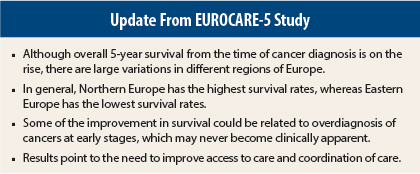EUROCARE-5, the latest in a series of comprehensive reports on the state of cancer survival in Europe, shows an improvement in 5-year survival from 1998 to 2007, with large variations among regions of Europe, according to a presentation at the European Cancer Congress.1 Furthermore, although 5-year survival rates have improved in Eastern European countries, that region has the lowest rates of survival, whereas Northern European countries fare the best, with the notable exception of the UK and Denmark, where survival was lower than in other countries with comparable income and health systems. Overall survival gains in some hematologic cancers are particularly impressive.
“Five-year survival adjusted for causes of death other than cancer increased steadily over time in Europe, particularly Eastern Europe, for most cancers. In general, there is a remarkable increase in survival for all hematologic malignancies,” said Milena Sant, MD, of Fondazione IRCCS Istituto Nazionale dei Tumori, Milan, Italy.
“Despite the increases in survival, the most dramatic geographical variations were observed for hematologic cancers, where there have been recent advances in treatment, such as chronic myeloid and lymphocytic leukemias [CML and CLL), non-Hodgkin lymphoma [NHL], two NHL subtypes—follicular and diffuse large B-cell lymphoma—and multiple myeloma. Hodgkin lymphoma was the exception, with smaller regional variations and a fairly good prognosis in most countries,” she continued.
In Dr. Sant’s view, the major contribution of this and other EUROCARE publications is to highlight regions at poor survival where actions are needed to better organize care and reduce its fragmentation in order to improve the outcome of cancer patients.
EUROCARE-5 is a massive undertaking. “This is the largest study of cancer patient survival in Europe, representing more than 50% of the European population. We have survival data on more than 20 million adult patients over age 15 from 31 countries followed from 2008 or later,” Dr. Sant said.
“Between 1998–2001 and 2005–2007, the largest increases in 5-year survival were observed in CML [from 32% to 54%], prostate cancer [73% to 82%], and rectal cancer [from 52% to 58%],” she continued.
Geographic Variation
Regional variation is high for cancers with a relatively good prognosis—breast, prostate, and colorectal cancers—but relatively low for poor-prognosis cancers, such as lung, pancreatic, and esophageal cancers.
The largest geographical variation for all hematologic cancers was observed in CML. Overall 5-year survival is now up to 54%, but the variability ranges from 56.1% for Northern Europe to 33.4% for Eastern Europe.
For NHL, the average 5-year survival is 59.4%, ranging from 63.3% in Northern Europe to 49% in Eastern Europe.
Survival in rectal cancer currently ranges from 59.5% in Northern Europe to 44.6% in Eastern Europe, and it is even lower than the regional mean in Latvia and Bulgaria.
Cancers that are detected by screening have large increases in 5-year and 10-year survival, Dr. Sant said. For example, breast cancer 5-year survival is now 70% in Eastern Europe, and melanoma has an 87.7% survival in Northern Europe and 74.6% in Eastern Europe. Dr. Sant attributed this improvement in part to educational campaigns regarding risk factors for melanoma leading to patient awareness of the need for screening and earlier stage at diagnosis.
“The large increment in survival for prostate cancer is related to a concomitant increase in incidence, which points to the problem of overdiagnosis with PSA [prostate-specific antigen] testing,” she noted.
Investing in Health Care
Survival correlated with gross domestic product and total national expenditure on health, with the exception of Denmark and the UK, “which continue to perform worse than expected for their level of total national expenditure on health and are in the lowest tertile for 5-year survival,” noted Dr. Sant. This phenomenon is also seen in the United States, which spends more per capita on health care than most other countries but lags behind for several health-care outcomes.
In an interview, Dr. Sant attributed this lackluster showing for Denmark and the UK to fragmentation of care and lack of coordination. “This problem—in the UK and Denmark—has been repeatedly highlighted. In 2000, EUROCARE published similar results with strong reactions and skepticism from people in those countries.”
Dr. Sant continued: “Our reports raised the consciousness, and now the UK government is investing 500 million pounds to improve services and shorten delays for referral to oncologists. Also, Denmark, Nordic countries, and the UK are collaborating on a recently launched project to understand disparities in care called the International Cancer Benchmarking Project,” she said.
“Further studies are needed to help reduce survival inequalities and improve cancer care, reduce the fragmentation of services, and promote comprehensive multidisciplinary care,” concluded Dr. Sant. ■
Disclosure: Dr. Sant reported no potential conflicts of interest.
Reference
1. Sant M, Francisci S, Minicozzi P, et al: Is Europe doing better in cancer care since the 90s? The latest findings from the EUROCARE-5 study. 2015 European Cancer Congress. Abstract 1LBA. Presented September 26, 2015.



